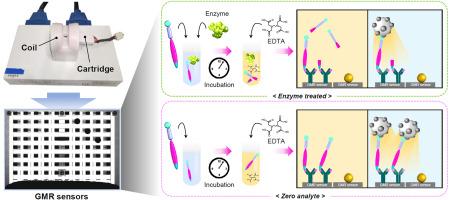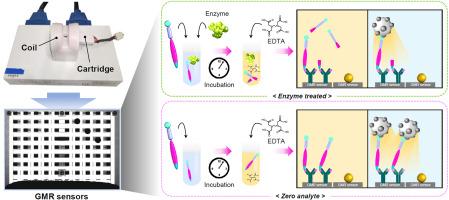Detection of factor Xa activity using giant magnetoresistive biosensors
IF 5.7
2区 化学
Q1 CHEMISTRY, ANALYTICAL
引用次数: 0
Abstract
Background
As anticoagulants are widely used to treat patients with atrial fibrillation (AF) and other thrombotic conditions, it is necessary for physicians to determine whether the medication has been taken in emergencies. Among many anticoagulants, rivaroxaban has attracted attention due to its safety and convenience. Since rivaroxaban inhibits activated coagulation factor X (factor Xa), measuring factor Xa activity can determine the presence of rivaroxaban.
Results
We report a magnetic biosensing platform capable of measuring the activity of factor Xa using peptide substrates conjugated with magnetic nanoparticles (MNPs). Due to the size of factor Xa, a new method of solution-phase assays was proposed for magnetic biosensing platforms to address issues with immobilized peptides on the sensors. This method was validated with factor Xa and trypsin, both of which are serine proteases. In the solution-phase assays, samples with either the enzymes of interest or no enzyme were simultaneously measured, and the activity of the enzyme was estimated using the difference between the measurements. Unlike conventional optical methods, our platform was capable of detecting the activity of factor Xa at 2 μg mL−1 with a 30 min sample incubation.
Significance
The assay using giant magnetoresistive biosensors outperformed conventional optical techniques. This platform can facilitate the determination of the presence of rivaroxaban and assist physicians in deciding on appropriate treatments for patients.


利用巨型磁阻生物传感器检测 Xa 因子活性
背景由于抗凝药物被广泛用于治疗心房颤动(房颤)和其他血栓性疾病患者,因此医生有必要确定患者是否在紧急情况下服用了药物。在众多抗凝药物中,利伐沙班因其安全性和便利性而备受关注。由于利伐沙班抑制活化的凝血因子 X(Xa 因子),因此测量 Xa 因子的活性可以确定是否服用了利伐沙班。结果我们报告了一种磁性生物传感平台,该平台能够利用与磁性纳米粒子(MNPs)共轭的多肽底物测量 Xa 因子的活性。由于因子 Xa 的大小,我们为磁性生物传感平台提出了一种溶液相检测的新方法,以解决传感器上固定肽的问题。该方法通过 Xa 因子和胰蛋白酶进行了验证,这两种酶都是丝氨酸蛋白酶。在溶液相分析中,同时测量含有相关酶或不含酶的样品,并利用测量值之差估算酶的活性。与传统的光学方法不同,我们的平台能够检测 2 μg mL-1 的 Xa 因子活性,样品孵育时间为 30 分钟。该平台有助于确定利伐沙班的存在,并帮助医生决定对患者的适当治疗。
本文章由计算机程序翻译,如有差异,请以英文原文为准。
求助全文
约1分钟内获得全文
求助全文
来源期刊

Analytica Chimica Acta
化学-分析化学
CiteScore
10.40
自引率
6.50%
发文量
1081
审稿时长
38 days
期刊介绍:
Analytica Chimica Acta has an open access mirror journal Analytica Chimica Acta: X, sharing the same aims and scope, editorial team, submission system and rigorous peer review.
Analytica Chimica Acta provides a forum for the rapid publication of original research, and critical, comprehensive reviews dealing with all aspects of fundamental and applied modern analytical chemistry. The journal welcomes the submission of research papers which report studies concerning the development of new and significant analytical methodologies. In determining the suitability of submitted articles for publication, particular scrutiny will be placed on the degree of novelty and impact of the research and the extent to which it adds to the existing body of knowledge in analytical chemistry.
 求助内容:
求助内容: 应助结果提醒方式:
应助结果提醒方式:


